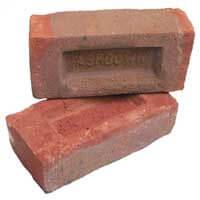- Brick is an artificial kind of stone (usually rectangular in shape) made of clay whose chief characteristics are plasticity when wet and stone-like hardness after being heated to a high temperature. Brick is a very important Building Material.
The earliest bricks were dried bricks, meaning they were formed from clay-bearing earth or mud and dried (usually in the sun) until they were strong enough for use. The oldest discovered bricks, originally made from shaped mud and dating before 7500 BC, were found at Tell Aswad, in the upper Tigris region and in southeast Anatolia close to Diyarbakir.
In pre-modern China, bricks were being used from the 2nd millennium BCE at a site near Xi'an. Bricks were produced on a larger scale under the Western Zhou dynasty about 3,000 years ago, and evidence for some of the first fired bricks ever made has been discovered in ruins dating back to the Zhou.
Early civilizations around the Mediterranean adopted the use of fired bricks, including the Ancient Greeks and Romans. The Roman legions operated mobile kilns,[citation needed] and built large brick structures throughout the Roman Empire, stamping the bricks with the seal of the legion.
Production of bricks increased massively with the onset of the Industrial Revolution and the rise in factory building in England. For reasons of speed and economy, bricks were increasingly preferred as building material to stone, even in areas where the stone was available. It was at this time in London, that bright red brick was chosen for construction to make the buildings more visible in the heavy fog and to prevent traffic accidents. {adselite}
What is Brick Made of?
Whatever the brick type, clay is the main ingredient of brick.
During preparing the brick raw materials, various types of clay are blended to get the required brick properties.
Different clay contains different propositions of minerals and chemical contents. This variation along with the temperature of the burner is responsible for the color of the brick. For example, clay with high iron oxide will produce reddish brick, and clay with high lime content will produce white or yellow hues brick.
As the mineral content of clay changes with locations, different colored bricks can be seen at different locations. For example, reddish-brown bricks are common in the northeast United States.
Brick Manufacturing Steps
Following are the main steps for brick manufacturing
- Preparation of soil
- Brick moulding
- Drying
- Burning
- Cooling
Brick Related Articles
- What is brick?
- Types of Bricks
- Composition of Bricks
- Characteristics of Good Bricks.
- Uses of brick.
- Compressive Strength of Brick
- Density of Brick
- Thermal Conductivity of Brick
- Advantages and Disadvantages of Hoffmann kiln.
- What is Refractory or Fire Bricks? Types, Composition
- Properties of Good Refractory Bricks
- Uses of Refractory Bricks
- Lime Pitting


